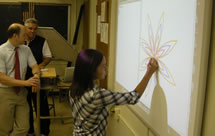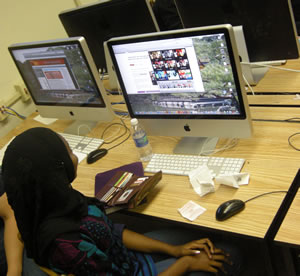
Philadelphia’s Central High School focuses on making its technology initiatives student-centered, with an emphasis on boosting achievement—and this focus has paid off in a big way.
Administrators, teachers, students, and parents are able to able to access grades, news, and pertinent communications instantly, and students have access to a wide range of applications to advance their learning. By strengthening the home-school connection, Central High is enhancing students’ chances of success.
For these reasons, Central High was chosen as our “eSchool of the Month” for October. Here, Brian Howland, a teacher and technology committee member, describes some of the school’s accomplishments and its keys to success.
(Editor’s note: To nominate your school or district for our “eSchool of the Month” feature, and to read about past winners, go to: http://www.eschoolnews.com/eschool-of-the-month.)
How does your school use technology to advance student learning?
Central High School uses in-school wired and wireless networks on iMacs and PCs. Our website, Centralhigh.net, based on the Edline platform, is used by administrators, faculty, students, parents, and alumni. Teachers have individual class pages; all sports teams and clubs have pages.
Integrated throughout are Grades (an application from EasyGradePro Web), interim reporting, calendars, school communications, and more.
We have five servers, five computer labs, and several smaller clustered labs, all using iMacs. We use TurnItIn plagiarism detection software, subscription-based research databases, and Follett Software’s Destiny online card catalog.
The purpose of technology at Central High is to serve the school community, to break down communication barriers between home and school, and to get as much information to the right people in the right format at the right time.
Have you noticed an increase in student performance and/or motivation as a result of this technology use? If so, how?
Teachers can post homework and grades online, and that information also is available to students and parents. The transparency of Edline allows students and parents to monitor progress at any time. Homework assignments are automatically placed on the students’ calendars, making it easy to check when something is due. In addition, homework can be submitted and automatically graded within Edline, then exported to EasyGradePro Grades.
Students’ performance has increased with the widespread implementation of TurnItIn, as many teachers use it for paper submission.
In the library, ProQuest databases allow students to search authoritative sites as opposed to merely Googling the whole internet.
Student compliance is close to 100 percent, and parents are closer to 30 percent, although many parents access the system with their children. With the start of the new school year, we have begun an initiative to bring more parents online.
How do you use technology to streamline school administration and aid in decision-making?
Through Edline, which drives our Centralhigh.net website, we communicate by means of banner headlines, links, and graphics. Links to daily school bulletins are on the home page.
The ability to eMail the whole school community allows us to let everyone know about urgent news quickly. For example, in October 2010, a fire closed school for a day; we got the word out, in part, through Centralhigh.net.
Counselors use Centralhigh.net to inform students of opportunities, scholarships, community service, and so on. Sports eligibility lists also get communicated through Centralhigh.net. School policies, admissions criteria, and a host of other administrative information about Central High all have links through or on the home page of Centralhigh.net.
We just implemented ScholarChip to take attendance by scanning student badges when they enter the building. Teachers take attendance online, from homeroom through the last period of the day. This eliminates a lot of paper on a daily basis, improves record-keeping, and makes our attendance figures more accurate.
Administration doesn’t hide things: The point of posting all of this information is to provide students, parents, staff, and alumni with the openness that should accompany public education.
Have you realized an increase in efficiency, a savings in administrative costs, a boost in staff or student performance, or some other tangible benefits as a result of this technology use? If so, how?
School performance has improved, as more information is available to more people more quickly than ever through ProQuest for research, TurnItIn for submission of papers, interim report cards, and most communication through Centralhigh.net.
In addition, Edline allows teachers to target eMail messages to groups of students, and parents if desired, as long as the recipients’ eMail addresses are registered in Centralhigh.net.
How have you financed your ed-tech initiatives—through grants? eRate funds? Local funds? Corporate partnerships? Or some combination of these techniques?
CHS pursues multiple funding sources, including AARP grants, state Classrooms of the Future grants, DonorsChoose (a website that enables community members to specify donations to schools), and alumni donors.
What ed-tech project are you most proud of, and why?
We’re most proud of Edline, because it incorporated so much so quickly.
What have been your biggest challenges in integrating technology into classrooms and school processes, and why? How have you overcome those challenges?
Every system implementation has challenges, and Central High continues to work on several. Key among these are the teachers’ learning curve and teacher training. To help overcome these, we have put in place professional development opportunities, supported by a core of technology teachers, and we’re trying to merge our technology club and staff technology team meetings for teachers.
What’s your best or most useful ed-tech advice for your colleagues?
We have three pieces of advice:
1. Keep the end result (student achievement) in mind.
2. Keep lines of communication open.
3. Ensure that everything you do is student-centered.
- SchoolStatus Launches SchoolStatus Boost, an Innovative Educator Development Solution for Enhanced Teacher Growth and Development - April 22, 2024
- Frontline Education Releases Inaugural K-12 Lens Survey Report To Guide K-12 Decision-Making - April 20, 2024
- Arizona’s Apache Junction Unified School District Supports Innovative Teaching and Learning with New EdTech Resources - April 19, 2024


